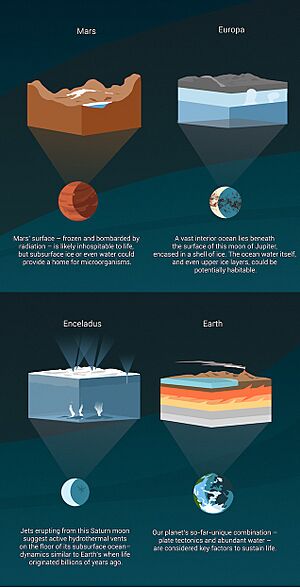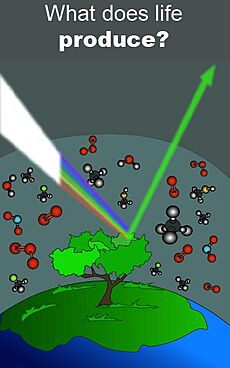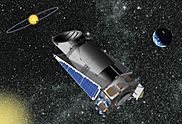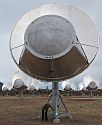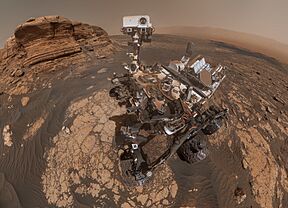Extraterrestrial life facts for kids
Extraterrestrial life, also called alien life, means life that comes from another world, not Earth. So far, scientists have not found clear proof of life anywhere else. This life could be very simple, like tiny prokaryotes (single-celled organisms), or it could be intelligent beings. These intelligent beings might even have civilizations that are much more or less advanced than ours. The study of extraterrestrial life is called astrobiology.
People have wondered about life beyond Earth for a very long time. Ancient thinkers like Epicurus imagined countless worlds in space. Even early Christian writers talked about the idea of many "worlds."
In the past, many writers thought other "worlds" were probably full of living things. For example, Nicholas of Cusa wrote in the 1400s that all other planets and stars could have people, plants, and animals, even the Sun.
Compared to Earth, most planets and moons in our Solar System and beyond have very harsh conditions. They might have extreme temperatures, strange air, or no air at all. However, Earth has many extreme places where life thrives. These include areas around hydrothermal vents (underwater hot springs), acidic hot springs, and volcanic lakes. Scientists think life might have started in such tough places on Earth. This makes them wonder if life could exist in similar harsh spots on other worlds.
Since the mid-1900s, scientists have been actively searching for signs of extraterrestrial life. This includes looking for life that exists now or existed in the past. They also specifically search for intelligent alien life. Space missions have explored planets like Venus, Mars, Europa, and Titan to see if they could support life. The first planets outside our Solar System, called exoplanets, were found in 1992. Scientists use telescopes and even listen for radio signals to find signs of life. So far, only the Voyager 1 and Voyager 2 probes have left our Solar System and entered space between stars.
The idea of extraterrestrial life, especially intelligent aliens, has greatly impacted our culture. It's a popular topic in science fiction books and movies. Science fiction has helped share scientific ideas and made people more interested in alien life. One big question is whether we should try to talk to intelligent aliens. Some people think we should try hard to make contact. Others worry it could be dangerous, remembering how advanced human societies sometimes treated less advanced ones.
Contents
The Universe and Life
The universe was too hot for life right after the Big Bang. It cooled down enough after about 15 million years. But the elements needed for life, like carbon and oxygen, didn't exist yet. They were made inside stars much later. Once stars formed, they created these heavier elements. When stars die, they release these elements back into space. These materials then form new stars and planets. Since this happens everywhere, the building blocks of life are common throughout the universe.
Earth is a planet in our Solar System, which orbits the Sun. Our Solar System is part of the Milky Way galaxy. The Milky Way is just one of many galaxies in the universe. The huge distances between stars and planets make it hard to study extraterrestrial life. Humans have only landed on the Moon and sent robots to other planets and moons in our Solar System. Even these robots take a long time to reach their destinations. For example, the New Horizons probe took nine years to reach Pluto. No probe has ever reached planets outside our Solar System.
There's a special area around a star called the "Goldilocks zone" or circumstellar habitable zone. In this zone, a planet's surface might be just the right temperature for liquid water. Water would turn into steam if it's too close to the star, or freeze if it's too far. However, being in this zone doesn't guarantee a planet has liquid water or life. Venus is in our Sun's habitable zone, but it has no liquid water because of its thick, hot atmosphere.
The Big Bang happened 13.8 billion years ago. Our Solar System formed 4.6 billion years ago. Life on other planets could have started, evolved, and even ended millions or billions of years ago. This shows how short the existence of species on Earth might seem in the grand scheme of the universe.
Life on Earth has adapted to almost every environment, even the most extreme ones. This suggests that life on other planets might also be very adaptable. However, the very beginning of life might have stricter needs. A planet could be habitable but still have no life on it.
Chances of Finding Life
It's a big question whether life, especially intelligent life, is common or rare in the universe.
Some scientists, like Carl Sagan and Stephen Hawking, believe life is probably common. They argue that the size of the universe means there are many planets like Earth. The age of the universe gives enough time for life to develop. Also, the chemical elements needed for life, like carbon and water, are found everywhere. Finally, the physical laws are the same across the universe. This means the conditions for life would be similar everywhere. This idea is part of the Copernican principle, which says Earth isn't special or unique in the universe.
Other scientists think life, especially complex life, might be very rare. The Rare Earth hypothesis suggests that many special factors came together to make life possible on Earth. These factors range from Earth's location in the galaxy to its specific features. They believe it's unlikely all these things would happen on another planet at the same time.
In 1961, astronomer Frank Drake created the Drake equation. This equation helps scientists think about how many intelligent civilizations might exist in our Milky Way galaxy. It looks like this:
Here, N is the number of civilizations that can communicate across space. The other letters stand for things like:
- R* = how many stars form in our galaxy each year
- fp = the fraction of those stars that have planets
- ne = the average number of planets that could support life
- fl = the fraction of planets that actually develop life
- fi = the fraction of planets where life becomes intelligent
- fc = the fraction of civilizations that can send signals into space
- L = how long those civilizations send signals
Drake made some guesses for these numbers, suggesting there could be 10,000 communicating civilizations. However, many of these numbers are just guesses, making the equation more of a way to start a discussion than to get a definite answer.
The Hubble Space Telescope has shown there are nearly 2 trillion galaxies in the observable universe. Scientists estimate that at least 10% of stars like our Sun have planets. This means there could be billions of planets that support life in the observable universe. A 2013 study using data from the Kepler spacecraft suggested our Milky Way galaxy alone has at least as many planets as stars, possibly 100–400 billion exoplanets.
The Fermi paradox is a puzzle: If there are so many planets and so much time, why haven't we found any evidence of alien civilizations?
What Alien Life Might Be Like
If extraterrestrial life exists, it could be anything from simple microorganisms to complex alien intelligences like humans. Scientists use what we know about life on Earth to imagine what alien life might be like.
Life needs a source of energy. On Earth, most life gets energy from the Sun. But there are other energy sources, like volcanoes, plate tectonics, and hydrothermal vents. Some Earth ecosystems deep in the ocean get energy from "black smokers" instead of sunlight.
Life on Earth also needs liquid water as a solvent. This means water helps chemical reactions happen. It's hard for life to start in a gas or solid. A liquid also helps move nutrients around. Planets with water, carbon, and other elements might form living things if their temperature is right. Some scientists have suggested life could use ammonia or liquid hydrocarbons like methane instead of water.
Another big question is what chemical elements alien life would be made of. Life on Earth is mostly made of carbon. But there could be other types of biochemistry. An element replacing carbon would need to form complex molecules and store information for evolution. Only a few elements can do this, like carbon, silicon, and nitrogen. Carbon is very common in the universe and forms strong, stable molecules. Silicon can also form complex molecules, but they are less stable and need very cold temperatures and no oxygen.
Even if alien life uses carbon and water, its chemistry could be very different from ours. Life on Earth started with simple RNA and then evolved to use DNA and proteins. Alien life might be stuck at an earlier stage or have evolved in completely different ways. However, it's likely that alien cells would still have a cell membrane to separate them from their environment.
The jump from simple cells to complex, multicellular life isn't guaranteed. On Earth, this happened many times, suggesting it might be common elsewhere. Scientists think that if evolution happens on other planets, alien animals might have similar features to ours, like bilateral symmetry (two matching sides), limbs, and heads with sensory organs.
Life in Harsh Earth Environments
It's true that conditions on other planets seem very harsh. They can have strong UV radiation, extreme temperatures, and no water. But on Earth, some of the earliest and simplest life forms appeared in extreme places. For example, hydrothermal vents on the ocean floor are super hot because of magma from inside the Earth. Yet, many bacteria live around these vents today. This shows that life can survive in very tough environments.
These harsh environments can be good for life because they allow chemical reactions to happen easily. For instance, organisms around hydrothermal vents use chemosynthesis. They get energy from chemicals instead of sunlight. This lets them live in places with little oxygen. Early Earth had low oxygen, so these chemical reactions were important for life to begin. If other planets have the right elements, similar chemical reactions could start life there too.
Planetary Habitability in Our Solar System
Our Solar System has many planets, dwarf planets, and moons. Scientists study each one to see if it could host life. So far, Earth is the only place where we've found life. No intelligent aliens have ever been found in our Solar System. Astrobiologists think it's unlikely we'd find large ecosystems, as we would have seen them by now.
The inner planets are probably without life. Venus is interesting because it might have been like Earth long ago. Now, it's extremely hot with a thick, poisonous atmosphere. Comparing Venus and Earth helps us understand what makes a planet good or bad for life. Some scientists wonder if tiny microbes could still live high up in Venus's clouds.
Mars is a cold, dry desert with almost no air. But studies show that Mars once had a lot of water, with rivers, lakes, and maybe even oceans. Life might have been possible then. But Mars lost its magnetic field, and solar winds stripped away its atmosphere. Old life forms might have left fossils, and microbes could still survive deep underground.
Giant planets like Jupiter and Saturn are unlikely to have life. The most distant objects in our Solar System are frozen solid, but scientists don't rule them out completely.
However, there's a lot of hope for finding life on the moons orbiting these giant planets. Europa, a moon of Jupiter, has a huge ocean under a thick ice layer. Ganymede and Callisto also have underground oceans, but life is less likely there because their water is trapped between layers of ice. Europa's ocean might touch its rocky core, which could help chemical reactions happen.
Enceladus, a tiny moon of Saturn, also has an underground ocean. It shoots water into space through geysers. The Cassini probe flew through one of these geysers and found complex organic molecules, salts, and signs of hot water activity. In December 2023, scientists found hydrogen cyanide and other organic molecules in Enceladus's plumes. These chemicals are important for life as we know it.
Titan, Saturn's largest moon, is the only other place in our Solar System with liquid on its surface. It has rivers, lakes, and rain made of hydrocarbons like methane and ethane. This makes scientists wonder if life could exist there with a different kind of chemistry. But it's very cold, so any chemistry would be super slow. Titan also has a deep underground water ocean.
Scientific Search for Life
The science that looks for and studies life in the universe is called astrobiology. By studying life on Earth, astrobiology tries to understand how life starts and evolves. This helps scientists know what to look for when searching for life elsewhere. Astrobiology combines many sciences, like astronomy, biology, chemistry, and geology.
Scientists search for extraterrestrial life directly and indirectly. As of 2017, over 3,600 exoplanets have been found. Other planets and moons in our Solar System might host simple life like microorganisms.
Looking for Simple Life
Scientists look for signs of life, called biosignatures, in our Solar System by studying planets and meteorites. Some have claimed to find evidence of tiny life forms on Mars. In 1996, a report said structures like nanobacteria were found in a meteorite from Mars. While these structures were later explained by non-living processes, this discovery helped start the field of astrobiology.
Experiments on the Viking Mars landers in the 1970s showed gas coming from heated Martian soil. Some scientists thought this meant living microbes were there. But other tests on the same samples didn't confirm this, suggesting it was a chemical reaction, not life.
In 2005, NASA scientists reported possible evidence of life on Mars based on methane found in its atmosphere. Methane can be produced by some simple life forms on Earth. However, NASA officials later said the claims were not definite.
In 2011, NASA launched the Mars Science Laboratory with the Curiosity rover. It landed on Mars in 2012 to study if Mars could have supported life in the past or present.
Scientists at Cornell University are creating a catalog of how different microorganisms react to sunlight. The goal is to find similar organisms on exoplanets. If a planet has a lot of these organisms, the light reflected from it would have a unique pattern. For example, if Earth were seen from far away, it would look green because of all the plants.
In 2011, scientists found important organic molecules, like adenine and guanine (parts of DNA), in meteorites from Antarctica. This suggests that the building blocks of life can form in asteroids and comets. In 2012, astronomers found a sugar molecule, glycolaldehyde, in a distant star system. This molecule is needed to form RNA, which is similar to DNA. This discovery suggests that complex organic molecules can form in star systems even before planets do.
Looking for Intelligent Life

While most searches focus on simple life, intelligent aliens might be found in other ways. Their technology could create "technosignatures" – effects on their planet that aren't natural. These could include interstellar communications, changes to their atmosphere, or giant structures like Dyson spheres.
Organizations like the SETI Institute search for alien communications. They started by listening for radio waves and now also look for laser pulses. The challenge is telling the difference between natural signals and artificial ones. Scientists hope to use artificial intelligence to help with this. Even if an advanced civilization exists, there's no guarantee they are sending signals our way. Also, signals take a very long time to travel across space.
An alien civilization's atmosphere might show signs of air pollution, like nitrogen dioxide. They might also use fossil fuels, like we do. The presence of chemicals like chlorofluorocarbons, which deplete ozone, could also be a clear sign of technology. Light pollution on the night side of a planet could also show advanced development. But our current telescopes aren't strong enough to see these details on exoplanets.
The Kardashev scale suggests that very advanced civilizations might get energy directly from their star. This would involve building huge structures, like Dyson spheres, around the star. These structures would cause the star to give off extra infrared radiation, which telescopes might detect.
Exoplanets
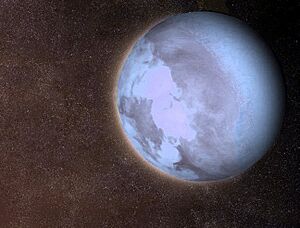
Astronomers search for planets outside our Solar System that could support life. They focus on rocky planets in their star's habitable zone. Since 1992, over four thousand exoplanets have been found.
Exoplanets vary greatly in size, from Earth-sized to much larger than Jupiter. The number of known exoplanets is growing fast. The Kepler space telescope found thousands of candidate planets.
On average, there's at least one planet per star. About 1 in 5 stars like our Sun have an "Earth-sized" planet in the habitable zone. The closest one is expected to be within 12 light-years of Earth. This means there could be billions of potentially habitable Earth-sized planets in our Milky Way galaxy.
One sign that a planet might have life is an atmosphere with a lot of oxygen. Oxygen is very reactive, so it wouldn't last long without something constantly making it, like plants through photosynthesis on Earth. Scientists can study an exoplanet's atmosphere when it passes in front of its star.
History and Cultural Impact
Cosmic Pluralism

The modern idea of extraterrestrial life is different from older beliefs. Ancient Greek thinkers were the first to try to understand the universe without myths. They thought the universe could be understood through reason. They developed ideas like Earth being round.
Two main groups emerged: the atomists believed everything, including the cosmos, was made of tiny atoms. The Aristotelians thought Earth was unique and the cosmos was made of a different substance. The atomist Epicurus believed that if Earth had animals and plants, other worlds should too. Aristotle, however, thought Earth was the only planet.
The idea of "cosmic pluralism," or many worlds, means believing there are many "worlds" besides Earth that might have life. Ancient Jain scriptures mention multiple "worlds" with human life. Medieval Muslim writers also supported the idea of many worlds based on their holy texts. However, these old ideas of "other worlds" were not like our modern understanding of planets orbiting stars. They imagined separate systems.
Early Modern Period
By the late Middle Ages, people realized the geocentric model (Earth at the center) had problems. Nicolaus Copernicus proposed that planets orbit the Sun, starting the Copernican Revolution. At first, his idea wasn't widely accepted. But Johannes Kepler later showed that planets orbit in ellipses, making Copernicus's model work much better.
The invention of the telescope by Galileo Galilei confirmed these new ideas. This new understanding made the idea of extraterrestrial life seem possible. If Earth is just a planet orbiting a star, then other stars might have planets like Earth. Galileo faced trouble from the Catholic Church for supporting the heliocentric model.
The Italian philosopher Giordano Bruno in the 1500s argued for an infinite universe where every star had its own planets. He believed other worlds were like Earth and had "animals and inhabitants." His belief in many worlds was one reason he was executed.
Sir Isaac Newton's theory of gravity further proved the heliocentric model. By this time, the scientific method became standard. Scientists began to seriously consider the possibility of life on other planets.
Many scientists in the 1700s and 1800s believed our Solar System was full of alien life. Even the Sun and Moon were thought to have inhabitants.
19th Century
In the late 1800s, people became very interested in life on Mars. Telescopes showed what looked like "Martian canals," but these turned out to be optical illusions. Still, astronomer Percival Lowell wrote books suggesting the canals were built by an old civilization.
However, by 1909, better telescopes showed that the "canals" were just natural features. The idea of Martians was debunked. The belief that life would just appear anywhere, called "spontaneous generation," was also disproved by Louis Pasteur in the 1800s. This meant scientists had to investigate how life actually began.
Science fiction began to develop in the late 1800s. It showed aliens as very different from humans, often with features from insects or octopuses. This influenced how people imagined aliens in real life.
Recent History
- The search for extrasolar planets (image: Kepler telescope)
- Listening for extraterrestrial signals indicating intelligence (image: Allen array)
- Robotic exploration of the Solar System (image: Curiosity rover on Mars)
The search for extraterrestrial life became its own science, astrobiology. NASA, ESA, and other space agencies study astrobiology. They look at life on Earth to understand how life starts and what it needs to survive. This helps them search for life elsewhere.
In the 20th century, technology advanced greatly. This led to more public interest in aliens. Some pseudosciences, like Ufology, claimed that unidentified flying objects (UFOs) were alien spaceships. Most UFO sightings can be explained by Earth-based aircraft, known astronomical objects, or weather.
By the 21st century, scientists accepted that complex life in our Solar System only exists on Earth. But interest in extraterrestrial life grew because of new discoveries. We now know more about what makes a planet habitable. Telescopes have improved, allowing us to find and study exoplanets. Robots can be sent to other planets to study samples directly.
Many scientists are hopeful about finding alien life. As SETI's Frank Drake said, "All we know for sure is that the sky is not littered with powerful microwave transmitters." This means aliens might communicate in ways we don't expect. The Wow! signal, detected in 1977 by a SETI project, is still a mystery.
However, other scientists are more pessimistic. Some believe that complex life like ours is very rare in the universe, while simple microbial life might be common.
Theoretical physicist Stephen Hawking warned in 2010 that humans should be careful about contacting alien life. He worried that aliens might come to Earth for resources. He compared it to when Christopher Columbus arrived in America, which didn't end well for the Native Americans. In 2015, Hawking and billionaire Yuri Milner started the Breakthrough Initiatives to expand the search for alien life.
Government Responses
The 1967 Outer Space Treaty and the 1979 Moon Agreement set rules for planetary protection. These rules aim to prevent Earth from being contaminated by alien life and to protect other planets from Earth's microbes. NASA has an office dedicated to preventing "backward contamination" of Earth by extraterrestrial life.
In 1977, a United Nations Office for Outer Space Affairs committee discussed how to interact with alien life, but they didn't reach any conclusions. As of 2010, the UN still doesn't have a plan for alien contact.
Many countries' space programs include searching for extraterrestrial life. China's space program, for example, lists this as a goal. Russia's space agency also sees it as a main goal for deep space research. The French space agency has an office that studies "non-identified aero spatial phenomena" and keeps a public database. Most of these phenomena have simple explanations, but about 25% remain unexplained.
See also
 In Spanish: Vida extraterrestre para niños
In Spanish: Vida extraterrestre para niños



